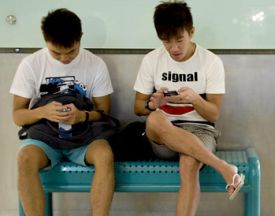The Philippines has “all the ingredients of an emerging tech tiger” — on paper, that is. Despite an enormous population “addicted to social media” and low labour costs, the “patchy at best” mobile internet coverage and “atrocious” internet speeds — a “measly 3.6 megabits per second (Mbps), well below the regional average of 12.4 Mbps” — seasoned Silicon Valley entrepeneur Peter Fabian describes the Philippine tech scene as more of looking like “the end of the world”.
The BBC News report, however, provides some consolation…
The Philippine start-up scene is small, but people are starting to trickle in. Some are adapting Western products to the local market, like fast fashion ecommerce, daily deals sites or taxi service apps.

| SUPPORT INDEPENDENT SOCIAL COMMENTARY! Subscribe to our Substack community GRP Insider to receive by email our in-depth free weekly newsletter. Subscribe to our Substack newsletter, GRP Insider! Learn more |
The Philippines is a vast consumer market. Much of this market is “unbanked” (the latest buzzword used by the world’s bankers scrounging around for growth opportunities in the Third World). This means that most Filipinos do not have credit cards and are therefore beyond the reach of sellers hawking their products via the Internet — for now. Tech investors see mobile devices as the key to bypassing this supply chain hitch.
In developing countries, mobile payment solutions have been deployed as a means of extending financial services to the community known as the “unbanked” or “underbanked,” which is estimated to be as much as 50% of the world’s adult population, according to Financial Access’ 2009 Report “Half the World is Unbanked”. These payment networks are often used for micropayments. The use of mobile payments in developing countries has attracted public and private funding by organizations such as the Bill and Melinda Gates Foundation, USAID and MercyCorps.
Mobile payment, also referred to as mobile money, mobile money transfer, and mobile wallet generally refer to payment services operated under financial regulation and performed from or via a mobile device. Instead of paying with cash, cheque, or credit cards, a consumer can use a mobile phone to pay for a wide range of services and digital or hard goods. Although the concept of using non-coin-based currency systems has a long history, it is only recently that the technology to support such systems has become widely available.
House Bill 3984, “An Act Liberalizing the Entry and Scope of the operations of Foreign Banks in the Philippines” seeks to remove bars to foreign banks fully owning banking operations in the country was passed in mid-May this year. This development could further improve prospects of introducing innovative solutions that could improve the ordinary Filipinos’ access to markets and products.
The bigger question remains as to whether Filipinos are culturally-attuned to reaping the benefits of increasing openness and access to technology. “Addiction to social media” does not equate to tech savviness any more than knowing how to drive a car necessarily makes one a competent mechanic. Open markets may benefit societies with long traditions of industrial, commercial, and marketing acumen but may ultimately bury under mountains of consumer debt societies with nothing more than a collective predisposition to spend and consume ultimately useless products and services.
[NB: Parts of this article were lifted from the Wikipedia.org article “Mobile payment” in a manner compliant to the terms stipulated in the Creative Commons Attribution-ShareAlike 3.0 Unported License that governs usage of content made available in this site.]
benign0 is the Webmaster of GetRealPhilippines.com.
Computers and computer related products/accessories are the Fads in our time…it is a positive development; because Filipinos can communicate each other fast and easy. SocialMedia activism has improved. We hope people will be better informed,on vital issues affecting them.
Monopoly of the Oligarchs on the banking system, has been going on for many years. They don’t want competition. They give lousy services (because you got no choice); and rip you out of your money….It is more like the Hacienda Luisita Plantation Economy of Aquino…
With a regularly rampant underground “hacking” scene of mobile smartphone technology in the Philippines (seedy vendors at Greenhills yelling, “download! download!” Wherever you’re in their turf.), I feel like the mobile money function can be somehow compromised by these jokers which only serve to prove the people’s lack of maturity to a more networked culture. Kleptocracy doesn’t just sit at the top honchos in the PH.